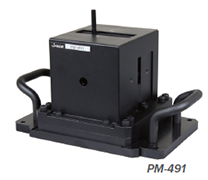
Magnetic circular dichroism (MCD) measurements can be made using a field generated by either a permanent, small electro- or super-conducting magnets. The MCD signal intensity is proportional to the magnetic field strength.
Chromophores with large magnetic moments arising from either rotational symmetries (aromatics, porphyrins), unpaired spins (metal complexes), or both (hemes) are sensitive to electronic perturbations and therefore provide information regarding the molecule’s electronic state. In protein molecules, MCD can be used as a probe to monitor the effects of magnetic field on a chromophore’s local environment.
- Permanent magnets with field strengths up to 1.6 tesla at ambient temperature
- Electro-magnets with field strengths up to 1.5 tesla
- Super-conducting magnets with field strengths in the region of 8 tesla or more




